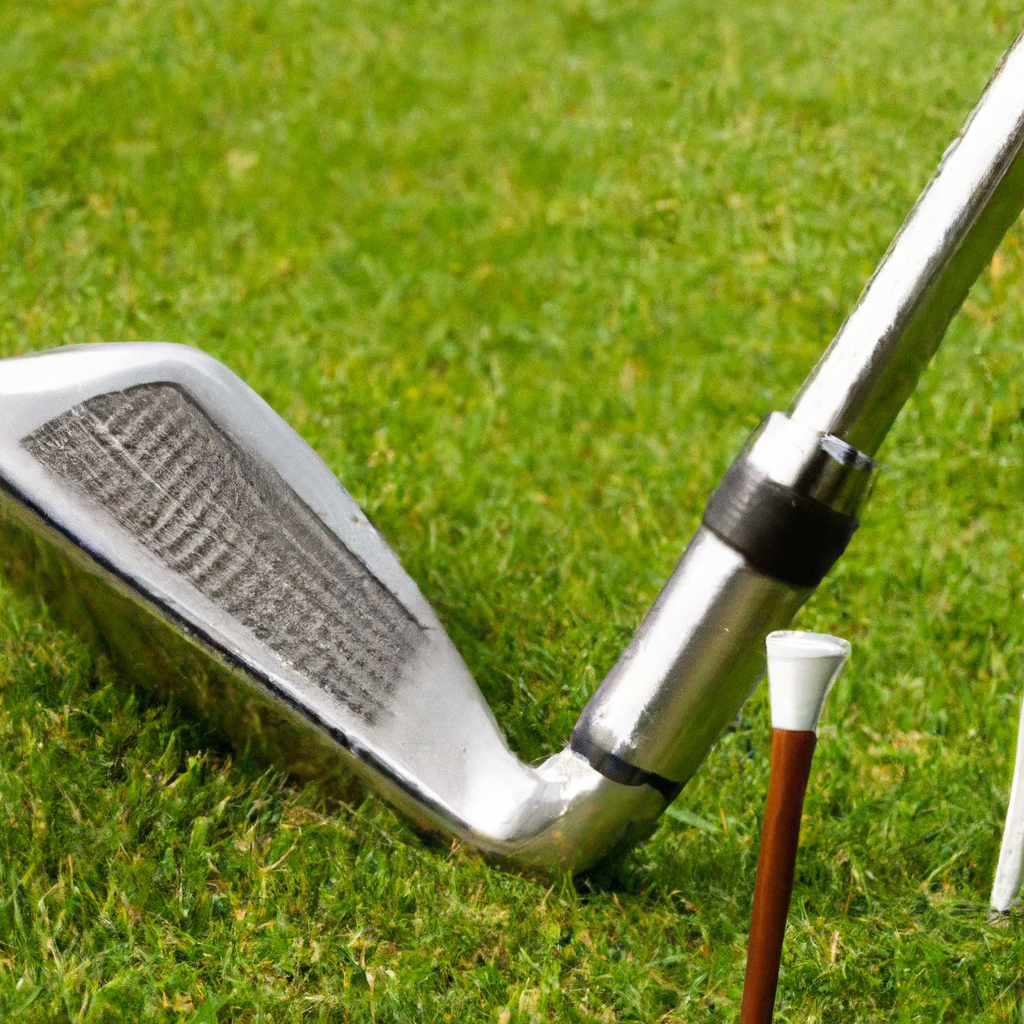Imagine you’re standing on the green, ready to tackle your next swing when suddenly, disaster strikes. Your trusty golf club’s shaft snaps, leaving you in a bind. But fear not! In this informative article, we’ll guide you through the process of changing the shaft on a golf club, step by step. Whether you’re a seasoned golfer or just starting out, this guide will have you back on the fairway in no time. So grab your tools and get ready to take your golf game to the next level!

Step 1: Gather the necessary tools
Before you start changing the shaft on your golf club, make sure you have all the necessary tools and materials. Here’s a list of what you’ll need:
Wrench or club head removal tool
A wrench or club head removal tool will come in handy when you need to detach the club head from the shaft.
Heat gun or blow dryer
Using a heat gun or blow dryer will help soften the adhesive and make it easier to remove the grip and old shaft.
Grip tape
Grip tape is used to provide a comfortable and secure grip on the club. Make sure you have enough grip tape to cover the length of the shaft.
Shaft epoxy
Shaft epoxy is a strong adhesive that is used to bond the new shaft to the club head. It is essential for a secure and durable connection.
Golf club extractor tool
A golf club extractor tool will be needed to safely and effectively remove the old shaft from the club head.
New golf shaft
Of course, you’ll need a new golf shaft to replace the old one. Make sure you choose a shaft that suits your playing style and preferences.
Golf grip
If you’re changing the shaft, it’s a good idea to replace the grip as well. Select a grip that feels comfortable and enhances your control over the club.
Sandpaper or abrasive belt
You may need sandpaper or an abrasive belt to smooth out any rough edges or surfaces during the process.
Knife or cutting tool
A knife or cutting tool will be useful when trimming the new shaft to the desired length.
Rubbing alcohol
Rubbing alcohol is used to clean the grip area and remove any residue before installing the new grip.
Step 2: Remove the old shaft
Now that you have all the necessary tools, it’s time to get started with removing the old shaft from your golf club.
Secure the golf club
First, make sure your golf club is securely positioned. You can use a vise or clamp to hold the club firmly in place, ensuring stability throughout the process.
Apply heat to the club head
Using a heat gun or blow dryer, apply heat to the club head. This will soften the adhesive and make it easier to remove the grip and old shaft. Be careful not to overheat the club head to avoid damaging it.
Remove the grip
Once the adhesive has softened, you can remove the grip by gently peeling it off with your hands or using a grip removal tool. Take your time and be patient to avoid tearing the grip or causing any damage.
Remove the club head
With the grip removed, you can now detach the club head from the shaft. If your club has a removable club head, use a wrench or club head removal tool to loosen and remove it. If it’s a one-piece club head, proceed to the next step.
Remove the old shaft
To remove the old shaft, you’ll need a golf club extractor tool. Follow the instructions provided with the tool to safely and effectively extract the old shaft from the club head. Take care not to damage the club head during this process.
Step 3: Prepare the new shaft
With the old shaft removed, it’s time to prepare the new shaft for installation.
Trim the new shaft to desired length
Using a knife or cutting tool, trim the new shaft to the desired length. It’s important to measure carefully and take into account your height and swing style. Remember, you can always trim the shaft a bit more later if needed, but you can’t add length back once it’s cut.
Prep the tip of the new shaft
Before attaching the new shaft to the club head, you’ll need to prepare the tip of the shaft. Use sandpaper or an abrasive belt to slightly roughen the tip, ensuring a better bond with the epoxy.
Apply epoxy to the tip of the new shaft
Next, apply a small amount of shaft epoxy to the tip of the new shaft. The epoxy should cover the entire tip evenly. Be sure to follow the manufacturer’s instructions for mixing and applying the epoxy.
Insert the new shaft into the club head
Carefully insert the new shaft into the club head’s hosel, making sure it is seated firmly and evenly. Take note of the alignment of the shaft and the club head face. Ensure the shaft is properly aligned and positioned according to your desired specifications.

Step 4: Align the shaft
Proper alignment of the shaft is crucial for optimal performance and accuracy. Take the time to align the shaft correctly with the club face.
Align the shaft with the club face
Ensure that the shaft is aligned perfectly with the club face. It should be positioned at the desired angle to achieve the desired loft and lie.
Check for proper lie angle
The lie angle refers to the angle between the shaft and the sole of the club head. Check that the new shaft’s lie angle matches your playing style and swing mechanics. Adjust if necessary.
Ensure proper loft angle
The loft angle determines the trajectory and height of the ball. Ensure that the new shaft’s loft angle matches your desired shot shape and distance. Adjust if needed.
Check grip orientation
Before moving on, double-check that the grip is aligned properly with the club face. You want the grip to be in the correct orientation for your grip preference and playing style.
Step 5: Bond the new shaft
With the shaft aligned and in the correct position, it’s time to bond it securely to the club head using epoxy.
Apply epoxy to the inside of the club head hosel
Carefully apply a thin, even layer of epoxy to the inside of the club head hosel. Be sure to cover the entire inside surface that will come into contact with the new shaft.
Insert the new shaft into the hosel
Gently insert the new shaft into the hosel, ensuring a snug fit. Avoid twisting or tilting the shaft excessively while inserting it.
Rotate the shaft to distribute the epoxy
Once the new shaft is inserted, give it a slight twist or rotation to distribute the epoxy evenly and create a solid bond between the shaft and the club head.
Clean excess epoxy
Wipe away any excess epoxy that may have squeezed out during the bonding process using a clean cloth or paper towel. It’s crucial to remove any excess epoxy before it hardens.
Step 6: Cure the epoxy
Now that the shaft is bonded to the club head, you need to let the epoxy cure for the recommended time.
Let the epoxy cure for recommended time
Refer to the instructions provided by the epoxy manufacturer for the recommended curing time. It’s important to give the epoxy enough time to harden and create a strong bond.
Apply heat to speed up the curing process
If you’re in a hurry or want to speed up the curing process, you can apply heat to the club head using a heat gun or blow dryer. Be careful not to overheat the club head, as this can cause damage.
Avoid moving or using the club during curing
While the epoxy cures, it’s crucial to avoid moving or using the club. Any motion or impact can interfere with the bonding process and result in a weaker connection.
Step 7: Prepare the grip
With the epoxy cured, it’s time to prepare the grip for installation.
Remove old grip (if necessary)
If you’re replacing the grip, remove the old grip from the club shaft. Use a grip removal tool or peel it off carefully by hand. Take care not to damage the shaft during this process.
Clean the grip area
Before installing the new grip, clean the grip area with rubbing alcohol to remove any residues or impurities. This will ensure a better bond between the grip tape and the shaft.
Apply grip tape
Apply grip tape to the cleaned area of the shaft. Make sure the grip tape covers the entire length of the grip area. Smooth out any wrinkles or creases for a clean and even installation.
Add tape layers for desired thickness
If you prefer a thicker grip, you can add additional layers of grip tape. This will increase the grip’s diameter and provide a more comfortable feel. Experiment with different tape layers until you find the desired thickness.
Step 8: Install the new grip
Now it’s time to install the new grip onto the shaft.
Apply grip solvent to the tape
Apply grip solvent to the grip tape and the inside of the grip. The solvent helps lubricate the grip, making it easier to slide on and adjust.
Slide the grip onto the shaft
Carefully slide the grip onto the shaft, making sure it aligns properly with the club face and the desired orientation. Use a twisting motion while sliding to evenly distribute the grip solvent and ensure a snug fit.
Align the grip properly
Double-check that the grip is aligned properly with the club face and your desired playing style. Make any adjustments if necessary to ensure a comfortable and suitable grip.
Secure the grip
Once the grip is in the desired position, allow it to settle for a moment. Then, use a grip clamp or grip tape to secure the grip firmly to the shaft. Follow the manufacturer’s instructions for the specific grip you’re using.
Step 9: Let the grip dry
Now that the grip is installed, you’ll need to let it dry before using the club.
Let the grip dry for recommended time
Refer to the manufacturer’s instructions for the recommended drying time. It’s important to allow the grip sufficient time to adhere to the grip tape and the shaft before using the club.
Avoid using the club until the grip is completely dry
While it may be tempting to test out your newly changed shaft, it’s crucial to refrain from using the club until the grip is completely dry. This will ensure a secure and long-lasting bond between the grip and the shaft.
Step 10: Check and adjust
Before taking your newly changed shaft out on the course, take the time to check for any issues and make necessary adjustments.
Inspect the club for any issues
Carefully inspect the club for any signs of damage or misalignment. Ensure that everything is securely bonded and aligned properly.
Make necessary adjustments
If you notice any issues or feel that something is not quite right, make the necessary adjustments. Whether it’s realigning the shaft or adjusting the grip’s position, take the time to make it perfect before using the club.
Test the club on the driving range
Once you’re satisfied with the alignment and adjustments, it’s time to take your club to the driving range for a test. Hit a few balls to get a feel for the new shaft and grip. Make note of any improvements or adjustments you may need to make for optimal performance.
Changing the shaft on a golf club can be a rewarding process that allows you to customize your equipment to suit your playing style. By following these step-by-step instructions and taking your time, you can successfully change the shaft on your golf club and enjoy improved performance on the course. Happy golfing!
